Proper climbing harness sizing is crucial for safety, comfort, and performance. This guide helps climbers determine the ideal fit, ensuring optimal support and mobility during ascents.
Overview of Climbing Harnesses
Climbing harnesses are essential gear for climbers, designed to securely attach a climber to a rope or anchor. Most harnesses are unisex, but some are tailored for men, women, or kids, with variations in design to accommodate different body types. Women’s harnesses typically feature a shorter torso and narrower hips, while men’s versions are longer and wider. Sizes range from XS to XL, based on waist and leg measurements. Proper fit ensures safety, comfort, and mobility. Key components include adjustable waistbelts, leg loops, and gear loops. While size charts guide selection, personal preference and adjustability play a significant role in achieving the ideal fit for various climbing activities.
Why Proper Fit Matters
A properly fitted climbing harness is critical for safety, comfort, and performance. A harness that is too tight can restrict movement and cause discomfort, while one that is too loose may not hold securely during a fall. Proper fit ensures the harness stays in place, distributing force evenly and reducing pressure points. It also allows for full mobility, enabling climbers to move freely and efficiently. Additionally, a well-fitted harness prevents gear loops from being uneven, which can hinder access to equipment. Personal preference, body type, and layering requirements also influence fit, making it essential to follow size charts and test the harness before use; A good fit enhances overall climbing confidence and enjoyment.
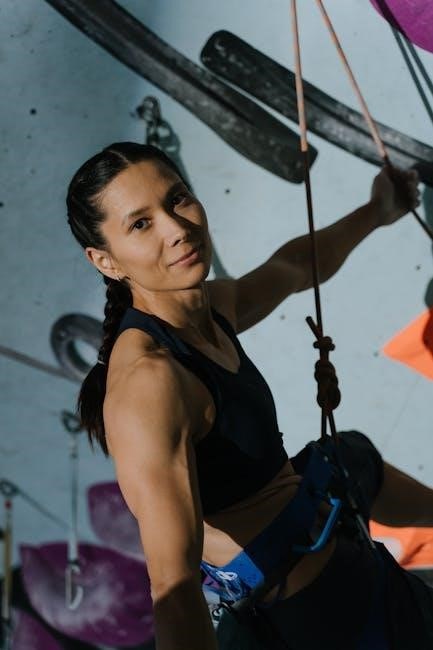
Key Considerations for Choosing the Right Size
Measure waist and leg circumference accurately, refer to manufacturer size charts, and consider body type, adjustability, and layering needs for optimal fit and comfort.
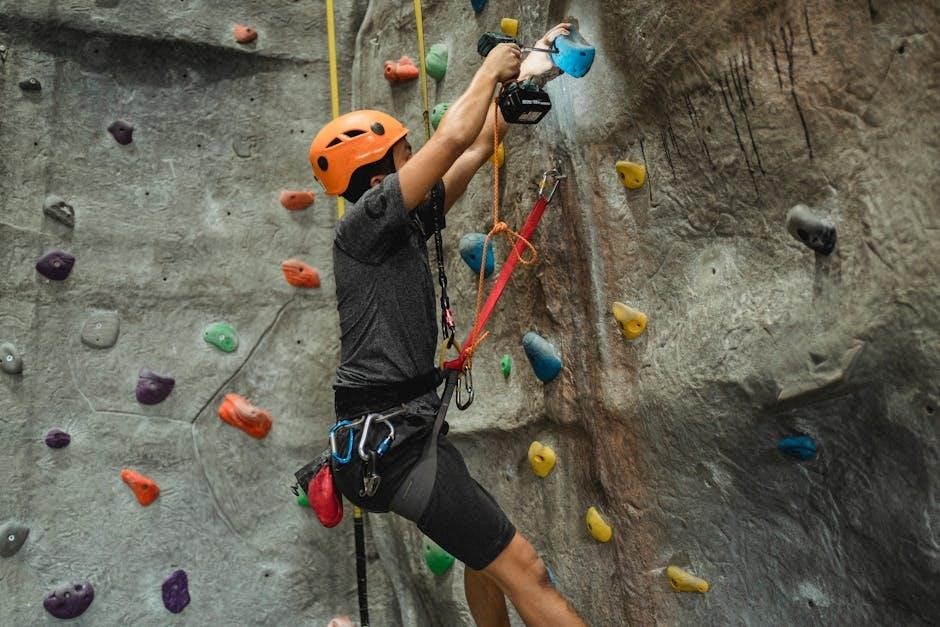
How to Measure Your Waist and Leg Circumference
To ensure an accurate fit, measure your waist at the narrowest point, typically just above the hipbone, using a flexible tape measure. For leg circumference, measure around the fullest part of your thigh, about 1-2 inches above the knee. Ensure the tape is snug but not overly tight. These measurements align with manufacturer size charts, which often provide waist and leg loop ranges for each harness size. Proper measurement is critical, as it directly impacts comfort, mobility, and safety while climbing. Double-check your measurements and consider seasonal layering, as thicker clothing may require adjustments to your harness size.
Understanding the Parts of a Climbing Harness
A climbing harness consists of key components designed for safety and functionality. The waistbelt, often adjustable with buckles, provides primary support and distributes force across the hips. Leg loops, connected to the waistbelt, secure the legs and should fit snugly without restricting movement. Gear loops, located on the waistbelt, allow climbers to carry equipment like carabiners and chalk bags. The belay loop, a reinforced point at the front, is used for attaching the rope during belaying. Properly understanding these parts helps climbers appreciate how harness sizing impacts both safety and comfort, ensuring a secure and functional fit for various climbing activities.
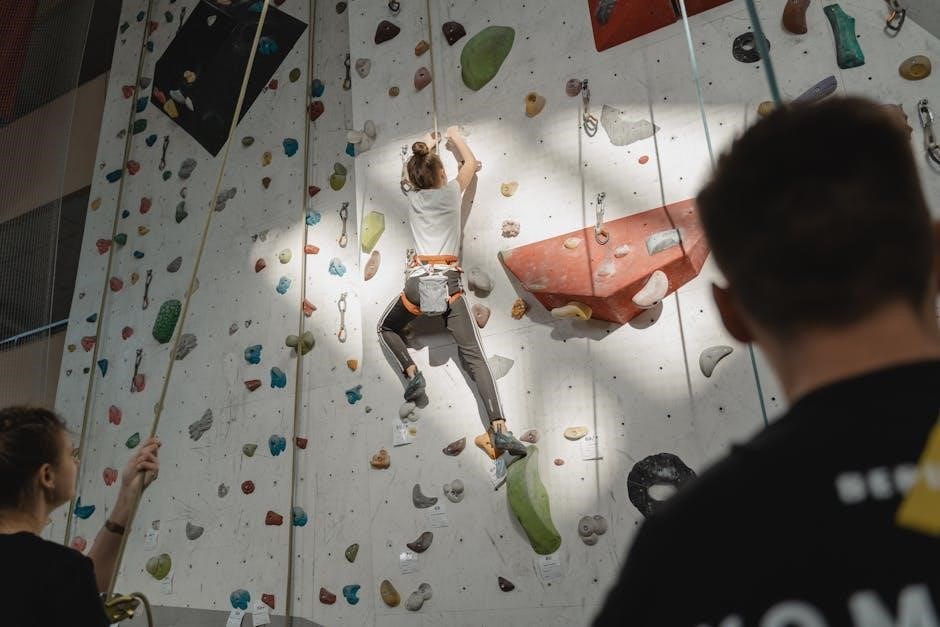
Men’s Climbing Harness Sizing
Men’s climbing harnesses are designed to fit longer torsos and wider hips, available in sizes XS to XL based on waist and leg measurements for optimal comfort and safety.
Size Charts for Men’s Harnesses

Men’s harnesses typically range from XS to XL, with sizing based on waist and leg circumference. Waist measurements generally fall between 27-39 inches (69-99 cm), while leg loops range from 19-21 inches (48-53 cm). For example, a Small size might accommodate a waist of 27.5-31.5 inches and legs of 19.5-21.5 inches. Medium covers 29.5-33.5 inches for the waist and 21.5-23.5 inches for the legs. Always refer to the manufacturer’s specific chart, as variations exist between brands. Proper fit ensures both comfort and safety, allowing for adjustability without compromising mobility or support during climbs. Adjustments should be made to center the belay loop and gear loops evenly.
Fit Tips for Men’s Harnesses
A well-fitted men’s harness should allow for a full range of motion while providing consistent support. Ensure the waistbelt sits comfortably above the hips, not too tight or loose. The leg loops should not restrict movement, with enough room to accommodate layers like climbing pants or base layers. Adjust the buckles so the belay loop is centered over the belly button for optimal weight distribution. Gear loops should be easily accessible without being too far back. If you layer up for colder conditions, consider a slightly larger size to maintain comfort. Regularly check and tighten the harness after initial adjustments to ensure safety and performance during climbs. Proper fit enhances both comfort and efficiency, making every ascent more enjoyable and secure.
Women’s Climbing Harness Sizing
Women’s climbing harnesses are tailored to fit shorter torsos and narrower hips, offering enhanced comfort and support during climbs, with adjustable features for a secure fit.
Size Charts for Women’s Harnesses
Women’s climbing harnesses typically come in sizes XS to XL, with specific measurements for waist and leg circumferences. Waist sizes generally range from 24-27 inches (61-69 cm) for XS, 27-30 inches (69-76 cm) for S, 30-33 inches (76-84 cm) for M, 33-36 inches (84-91 cm) for L, and 36-39 inches (91-99 cm) for XL. Leg loops range from 17-19 inches (43-48 cm) for XS to 19-21 inches (48-53 cm) for XL. These charts vary slightly by brand, so it’s essential to refer to the manufacturer’s specific sizing guide. Always measure your waist at the narrowest point and thighs at the fullest part for accurate sizing. Proper fit ensures comfort, mobility, and safety while climbing.
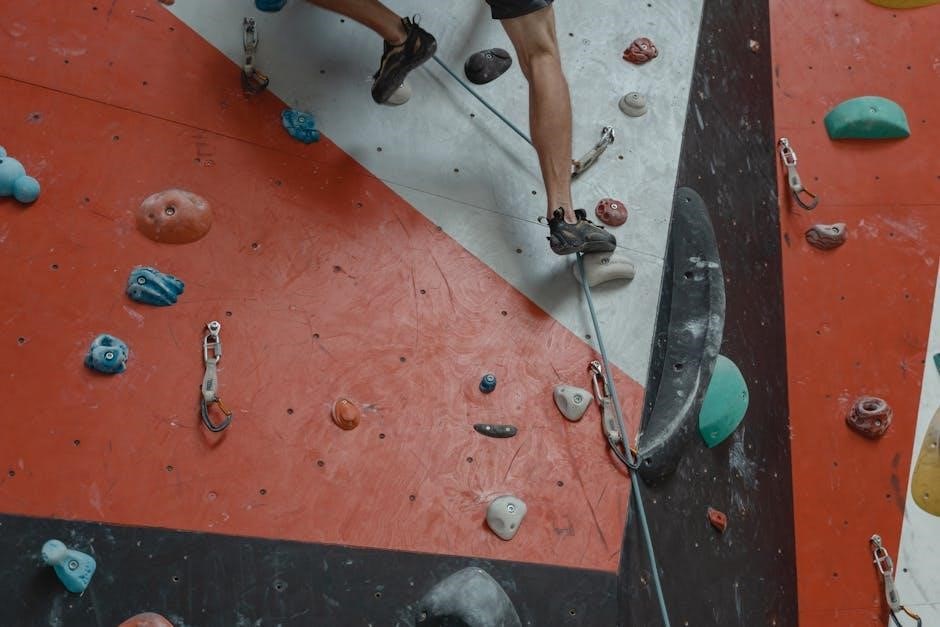
Fit Tips for Women’s Harnesses
A well-fitted women’s climbing harness is essential for both safety and comfort. Ensure the waist belt sits snugly around your natural waistline, avoiding gaps. The leg loops should fit comfortably without restricting movement or feeling too tight. Adjust the straps so the harness feels secure but not constricting. It’s important to try the harness on with the clothing you’ll typically climb in, as bulkier layers can affect the fit. Avoid over-tightening, as this can impede circulation and mobility. Properly adjusted, the harness should allow for a full range of motion while keeping you secure during climbs. Remember, the right fit enhances performance and ensures a more enjoyable climbing experience.
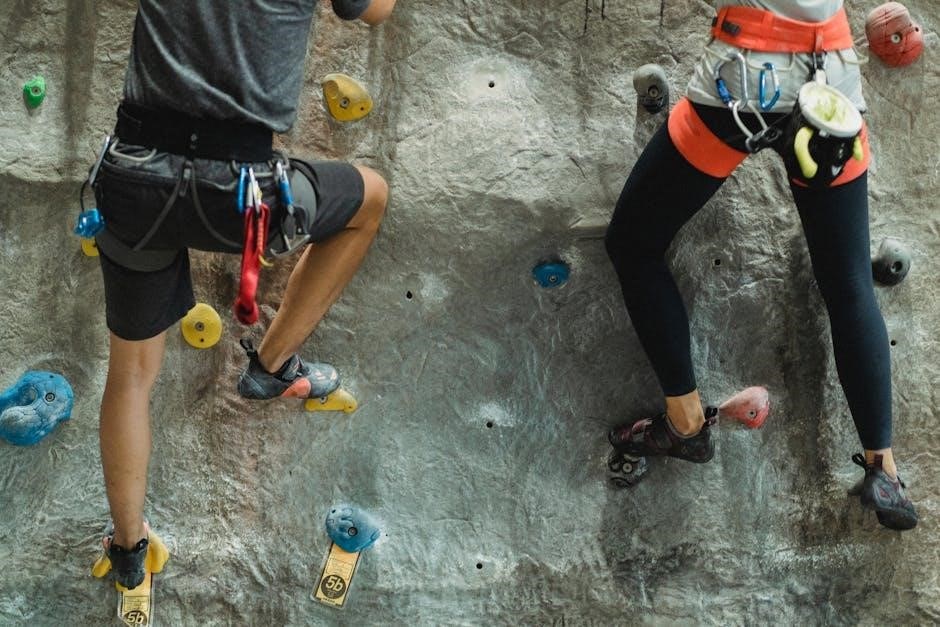
Climbing Harness Sizing for Kids
Ensuring proper fit is critical for children’s climbing harnesses to guarantee safety and comfort. Harnesses designed for kids often feature adjustable straps to accommodate growth and varying body types. When sizing, measure your child’s waist and thigh circumference to match the manufacturer’s size chart. The waist belt should sit snugly above the hips, and leg loops should not be overly tight. Look for harnesses with padding and flexible designs for added comfort. Adjustable elements allow the harness to grow with your child, providing long-term usability. Always test the fit with the climbing gear your child will use, ensuring full mobility and security. Proper sizing ensures your child can climb confidently and safely, regardless of their skill level or activity.
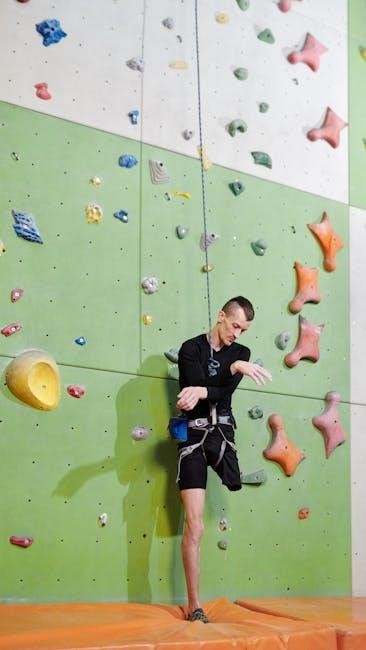
How to Choose the Right Size
Use manufacturer size charts to align your waist and leg measurements. Ensure adjustability, considering layering and personal comfort, to select a harness that fits securely and allows mobility.
Using Manufacturer Size Charts
Manufacturer size charts are essential tools for selecting the right harness. They typically provide waist and leg circumference ranges for each size, from XS to XL. Measure your waist at the narrowest point and your thighs at the fullest part. Compare these measurements to the chart to find your size. Some brands also offer unisex and gender-specific options, so check the design suited to your body type. Adjustability is key; ensure the harness can tighten or loosen to accommodate layering or body changes. Always follow the manufacturer’s guidelines closely to ensure a safe and comfortable fit for optimal climbing performance.
Personal Preference and Adjustability
Personal preference plays a significant role in choosing a harness size, as climbers prioritize comfort, mobility, and support differently. Some prefer a snug fit for sport climbing, while others opt for a looser fit for all-day comfort. Adjustability is key, as it allows the harness to accommodate layering, weight changes, or varying conditions. Look for harnesses with adjustable buckles and leg loops to customize the fit. Seasonal climbing may require adjusting for thicker clothing, so ensure the harness can adapt. Ultimately, the right size balances comfort, mobility, and safety, making personal preference and adjustability critical factors in your decision.
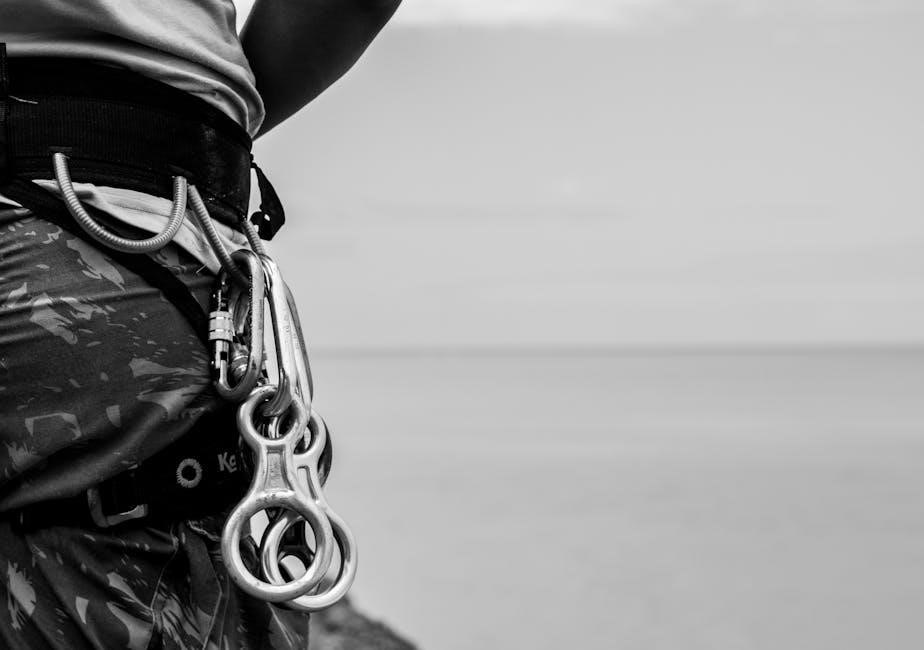
Factors That Can Affect Harness Fit
Body type, seasonal layering, and weight fluctuations can influence harness fit, requiring adjustments for comfort and safety during climbs. Proper sizing ensures optimal performance and mobility.
Body Type and Sizing Variations
Body type significantly impacts harness fit. Climbers with shorter torsos may prefer women’s models, which are designed for narrower hips and higher waist straps. Conversely, taller individuals or those with broader frames often find men’s harnesses more comfortable, as they offer longer torsos and wider waist belts. Leg loop sizing also varies, with some harnesses catering to slimmer or thicker thighs. Manufacturers provide size charts based on waist and thigh measurements to help climbers choose the best fit. However, body proportions can vary widely, so trying on a harness or comparing detailed size guides is essential for optimal comfort and safety.
Layering and Seasonal Considerations
Layering and seasonal changes can affect harness fit. In colder conditions, climbers often wear thick layers, which may require a slightly larger size to accommodate insulation. Adjustable harnesses are beneficial for such situations, allowing for flexibility. Conversely, in warmer weather, a snug fit without excess material is preferable. Seasonal variations in body weight or muscle mass should also be considered when selecting a size. Manufacturers recommend choosing a harness with enough adjustability to account for these factors. Ensuring the harness can accommodate both layered clothing and seasonal physique changes is key to maintaining comfort and functionality during climbs.
Harness Sizing Across Different Brands
Harness sizing can vary significantly between brands due to differences in design and target use. For example, Petzl and EDELRID offer detailed size charts with specific waist and leg measurements, while other brands may have more generalized sizing. It’s essential to compare measurements across brands, as a size small in one brand may not fit the same as another. Seasonal layering and personal preference for snugness or looseness can also influence size selection. Always refer to the manufacturer’s sizing chart and consider trying on a harness if possible. Proper fit ensures safety, comfort, and optimal performance, regardless of the brand chosen.
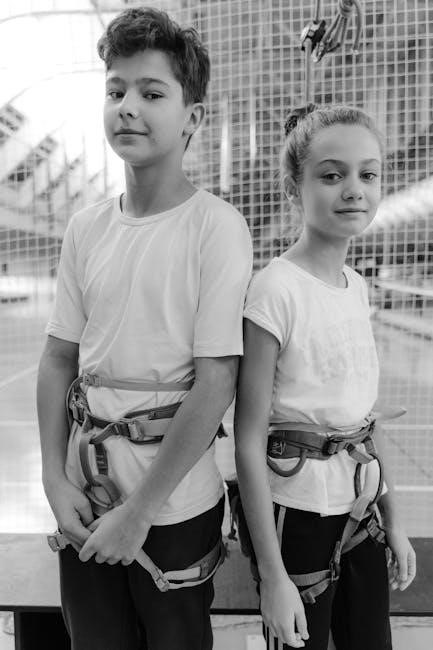
Common Mistakes to Avoid
When selecting a climbing harness, avoid relying solely on manufacturer size charts without considering personal comfort. Many climbers mistakenly choose a size too tight or too loose, compromising mobility and safety. Another error is ignoring how layering affects fit, especially in cold conditions. Additionally, some climbers overlook the importance of proper leg loop sizing, which can cause discomfort or restricted movement. It’s also common to neglect trying the harness on before purchase, leading to poor fit. Always ensure the harness is adjustable enough to accommodate layers and personal preference, and avoid settling for a size that doesn’t align with your measurements or comfort needs.
Selecting the right climbing harness size is essential for both safety and comfort. By understanding your measurements, consulting manufacturer charts, and considering personal preferences, you can ensure a proper fit. Remember to account for layering and seasonal changes, as these factors can impact how your harness feels. Avoid common mistakes like sizing too tight or too loose, and always prioritize adjustability. Whether you’re a seasoned climber or just starting out, taking the time to choose the correct harness size will enhance your climbing experience and provide peace of mind on every ascent.